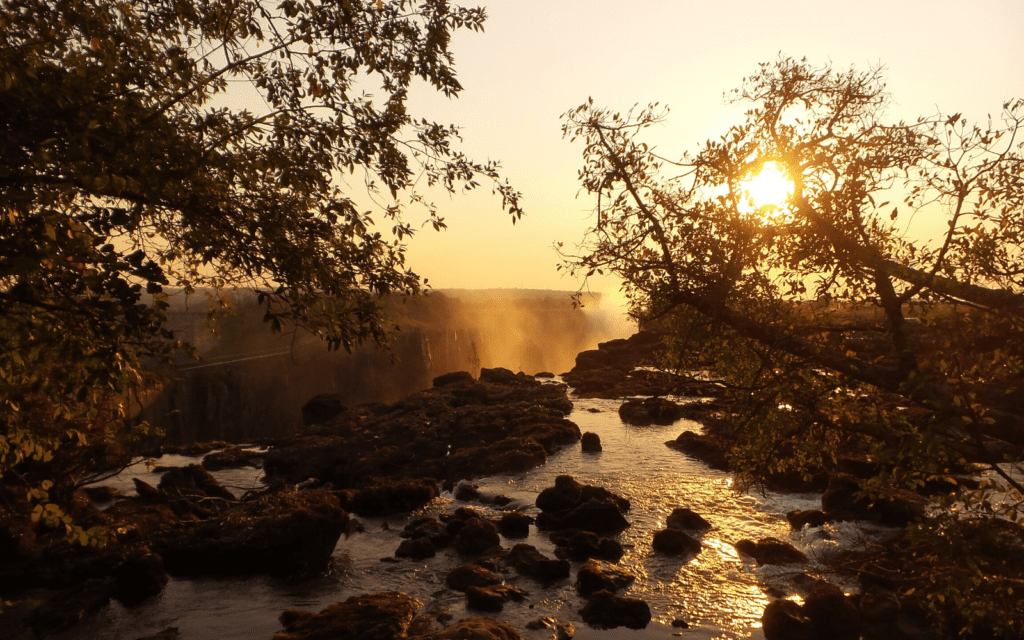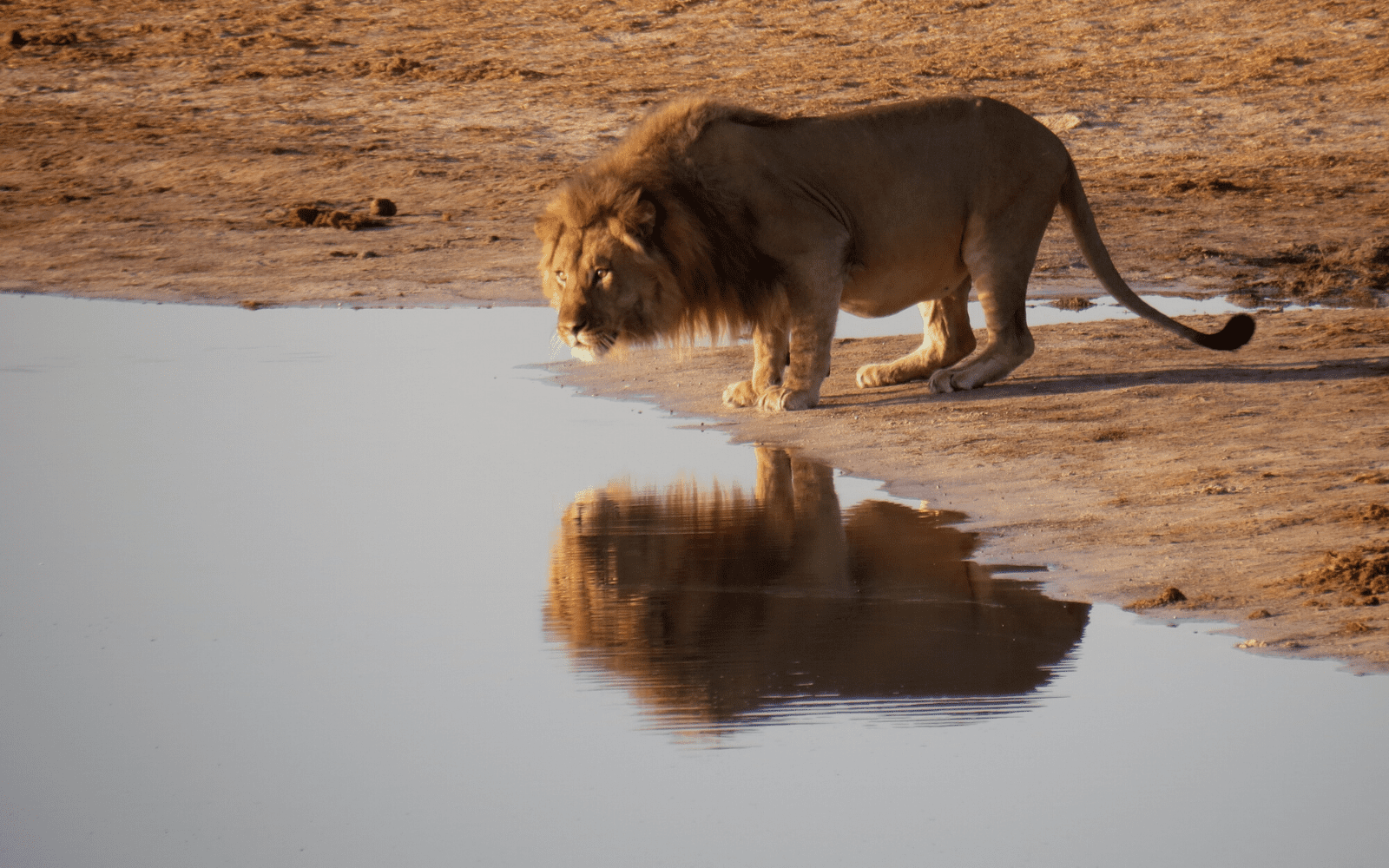Zimbabwe is a rugged destination guaranteed to please the safari traveler on the lookout for an authentic African experience.
Walking in Zimbabwe is never typical, but it is always authentically thrilling. Quietly you shift your feet in the dusty earth. You quickly take a sharp breath and feel the need to hold it while the elephant scans your way. Head cocked to the side slightly, listening, the massive matriarch slowly raises her trunk in the air and sniffs. Crouching behind a fallen tree with your walking companions and expert guide, she cannot smell you because your guide has perfect positioned you to observe the herd. You are a safe distance away but close enough to hear the rumbles emitted by the majestic leader to her family. You marvel at her size as her calm attention is turned to the rumpus behind her as calves playfully splash in the waterhole under the watchful eyes of their mamas and aunties. The smallest calf cannot keep control of his trunk as he tries to drink. It’s comical, magical, and incredible all at once.

Visit Zimbabwe
Known as Southern Rhodesia in colonial times, Zimbabwe sits on a plateau just north of the Tropic of Capricorn in Southern Africa. Entirely landlocked, Zimbabwe lies between the Limpopo River to the South and the Zambezi River to the North.This nation is blessed with an abundance of world-class water attractions…and where there is water, there are animals. Some of the most dramatic landscapes, prolific wildlife populations, and lowest density of tourists are found within Zimbabwe’s borders. Add to this some of the most qualified guides on the continent due to the rigorous training period and certifications, and you have the makings of an outstanding safari experience. Guests can partake in a vast array of activities here; from all the adrenaline adventures near the stunning beauty of Victoria Falls, to floating in a houseboat on the largest man-made lake in the world at Lake Kariba, to swapping the game drive for a game canoe in Mana Pools and Matusadona, Zimbabwe is a gem of a destination. Below we delve into what makes this gem sparkle.
10 things we love most about a Zimbabwe safari…
Image © Leora Rothschild and Jeremy Pagden — unsplash.com
1. It is extraordinarily beautiful.
On a continent full of natural beauty, Zimbabwe seems to have gotten the lion’s share (pun intended). The languid meandering of the Zambezi through Mana Pools National Park against the soaring rift escarpment is simply breathtaking while that same river is intense, turbulent and equally gorgeous at Victoria Falls.
2. The private concessions and conservancies of a Zimbabwe safari.
Despite recent history, dedicated individuals passionate about this nation’s heritage have miraculously sustained the National Parks and conservancies which protect the Zimbabwean wildlife. Wildlife populations have remained remarkably intact and the natural areas have been preserved instead of plundered for resources. The recent refurbishment of iconic properties and investment in some new camps and lodges is a testament to the unsinkable spirit of Zimbabweans.
3. Victoria Falls in full flow
Yes, it’s undeniably impressive to see the falls, known in the local Shona language as Mosi-oa-Tunya or ‘Smoke that Thunders’ when it is in full flow. Then again, when it comes to the largest waterfall on earth, ‘experience’ might be a better description than ‘see’ because when the entire might of the Zambezi River rushes into Batoka Gorge at high water levels, your visit is not unlike stepping into the world’s most extraordinary power shower. The mist shrouds and swirls through the forests and you will undoubtedly want a poncho to keep dry. That being said, it is refreshing to be cleansed by the waters from the falls. Water levels typically diminish throughout the winter and into the Spring of September.
4. Victoria Falls in low flow
And then, when the natural low season starts, Victoria Falls reveals an entirely new side with the mysteries in the bowels of the gorge exposed. The pools at the very top of this majestic geological phenomenon known as Devil’s and Angel’s pools become accessible for those brave enough to swim in them. Your heart might race and the blood will be coursing faster through your veins as you wade into the river with your trained guide. Then you float and bob and let the current carry you to the lip of the pool–just enough of a barrier to keep you safely exhilarated while you take in one of the rarest views of Victoria Falls.
There are many activities that do not depend on water levels in this area and you can always enjoy the local markets and traditional villages, take a scenic flight, have tea with elephants, go bungee jumping, game viewing, or cruising the Zambezi River at sunset (just to name a few…).
5. Hwange National Park
A short drive from Victoria Falls lies Hwange National Park – the iconic Zimbabwean safari destination.
Most come to Africa for the animals and in Hwange you will find lions, leopards, hyenas, magnificent herds of elephant (the densest concentration of elephant after Botswana’s Chobe National Park) and buffalo. In addition, you will find plains game like antelope, giraffe, and zebra. Activities in the park focus around game drives in open safari vehicles, traditional walking safaris where you investigate the smaller creatures that are not easily seen from a vehicle, and fantastic bird watching.
Visit Hwange between June and October.
6. Mana Pools National Park
Beautiful wild riparian scenery, filled with game and the opportunity to take guided walking safaris. As the park lies along the Zambezi River, forests and floodplains can be explored by game drive vehicles, on foot, by canoe or boat. A Mana safari is a wonderful, off-the-beaten-track experience.
Plan to canoe in Mana Pools from June to October when the temperature is low but the wildlife congregates along the river banks.
7. Matusadona National Park
Venture a little further to the shores of Lake Kariba where you can see rhino in Matusadona National Park and delight in game viewing during your boat safari on the world’s largest man-made lake. Watch out for the giant crocodiles!
8. Gonarezhou National Park
Fly into Gonarezhou National Park for mega-herds of elephant, cats, and almost 400 bird species. The sandstone Chilojo Cliffs rise 600 feet (180 m) high in the center of the park, carved by water over eons.
9. Matobo National Park
An incredible location for the intrepid traveler, Matobo Hills also offers the rare opportunity to participate in rhino tracking. Ancient rock art by the San Bushmen can be viewed here.
10. The people you meet on a Zimbabwe safari
The warm genuine people and impeccable service are a close second to the beautiful wildlife experiences.
Seasons in Zimbabwe
Rain is expected between mid-November and towards the end of March in Zimbabwe. These months feature afternoon storms with hot and humid conditions. As this is the low season, all the parks will be very quiet. The bush is lush and green and over 600 species of birds may be spotted, however the wildlife viewing is not as productive as in the dry months. In April and May the rains are starting to lessen although the country remains wet and lush. There are still many calves.
During the winter (June through October) the weather is cool, dry and sunny with clear, cold (but starry) nights. There is virtually no rain and the risk of malaria is low. This is the best time to visit. The High Season runs between July and October, but the bush is never crowded in Zimbabwe, it is only busy right around Victoria Falls. From mid-August until the first rains arrive the humidity is low but the temperatures are very high. September and October are extremely hot and dry months.
A Zimbabwe Safari in January

This is the beginning of Zimbabwe’s main rainy season, temperatures are warm with afternoon thunderstorms and high humidity. It’s all about lush landscape and new babies in the wet season.
This is the low season and you can expect very few travelers.
Large herds of wildebeest and zebra with calves abound. It is a great month for photography and bird watching as many species are constructing nests. As the animals don’t need to rely exclusively on waterholes, access to open plains for game viewing is essential.
Crossing the border to Zambia to swim in the Devil’s Pool is usually still possible to the middle of January.
Many Mana Pools camps are closed and roads can be impassable in places.
Expect temperatures between 88 and 61o F (31 o C and 16 o C).
A Zimbabwe Safari in February

Safari camps often have lower prices. You will find lots of small creatures (Sable antelope and waterbuck calves, as well as ducklings and other waterfowl hatchlings) and much rain.
Expect thunder and lightning in the afternoons and rain that may last for days on end.
The white-water rafting on the Zambezi can be dramatic during low water.
Expect temperatures between 88 and 61o F (31 o C and 16 o C).
A Zimbabwe Safari in March

It often rains during the afternoons making the bush lush, and the night time temperatures start dropping. Safari camp prices are still low and it can often rain for days. The countryside is quite beautiful with water lilies and Victoria Falls is filling up with rainbows twinkling through the spray.
Expect temperatures between 88 and 59o F (31 o C and 15 o C).
A Zimbabwe Safari in April

The dry season is now around the corner with fewer rain showers and slightly cooler temperatures. We are on the cusp of Zimbabwe’s ‘champagne’ months with blue skies and perfect temperatures. Spot rhino and elephant calves and migrant birds gathering before their long flights.
Mana Pool National Park is open, the camps are accessible and rates are still low with quiet parks.
As the water rises, white water rafting stops because the flow is too fast to be on the river safely.
Leading up to the full moon under clear skies, Victoria Falls should have moonbows; which are rainbows created at night from the moonlight reflecting off droplets of water from the Falls’ spray.
Expect temperatures between 88 and 55o F (31 o C and 13 o C).
A Zimbabwe Safari in May

At the start of the dry season, the Zimbabwean bush begins to dry up and all the animals gather around available water sources. Temperatures begin to drop (between 81 and 50o F) as cloudless days bring almost no rain. It can be quite cool at night and while you can leave your raincoat behind you may need layers for your cool early morning and late evening game drives.
Victoria Falls, the world’s largest waterfall, is in full flow but this also means the Zambezi is flowing too high and fast to allow safe white water rafting.
Victoria Falls should have moonbows during the full moon.
Expect temperatures between 84 and 48o F (29 o C and 9 o C).
A Zimbabwe Safari in June

The high season is upon us. This means exceptional wildlife sightings and the spray from Victoria Falls might make it harder for viewing.
Any chance of rain is extremely slim at the beginning of the dry winter season. Do pack warm layers (including hats and gloves) for cool early mornings and nights around the campfire…and prepare for a hot water bottle in your bed and magical misty mornings.
The season is not yet in full swing making the travel hotspots less crowded. Popular spots can fill up quickly and prices will be on the rise.
Victoria Falls should have moonbows during the full moon. The high water will allow for ‘high water river rafting runs’ and spectacular scenic helicopter flights.
Expect temperatures between 79 and 45o F (26 o C and 7o C). Temperatures in Hwange can drop as low as 14o F (-10 o C) during the night.
A Zimbabwe Safari in July

The Zimbabwean high season is a celebration of massive elephant herds and other game around the remaining water sources of Zimbabwe’s dry bush. (temperatures are between 77 and 43o F).
At this time of year, Southern Africa can be close to freezing at night, although the days are often still mild with dry, sunny days.
At peak season it can be very difficult to find space in your preferred lodge, prices are also at their peak as the wildlife is easy to spot as the landscape opens up.
Victoria Falls should still have moonbows during the full moon phase.
Expect temperatures between 79 and 43o F (26 o C and 6o C).
A Zimbabwe Safari in August

At the height of Zimbabwe’s game-viewing season, spring has arrived and the wildlife gathers in great numbers around the country’s water sources. Expect bright, clear days with cool nights and almost no rain.
The signature Msasa trees are showing off their most extravagant foliage and migrant birds are returning. Watch out when you walk underneath a Sausage tree! The large seeds can weigh up to 11 lb (5 kg) and the August winds can dislodge them to fall on unsuspecting passers-by.
Victoria Falls has much less water falling into the gorge making it possible to view the ancient geology behind this wonder. In Zimbabwe’s cloud forest the best seats in the house still allow for spotting the famous rainbows.
Often the busiest month in the tourist calendar; lodges and camps are full and prices are high. This is also a time when bush fires can add an extra bit of drama to your safari from afar.
The very best time to go white water rafting begins as the volume and speed of the water allow for a great day out. The Devil’s Pool and Angel’s Pool usually open around the middle of August.
This is usually your last opportunity to spy a moonbow during the full moon at Victoria Falls.
Expect temperatures between 84 and 48o F (29 o C and 9o C).
A Zimbabwe Safari in September

September is an extension of the August experience with one distinction: temperatures are now noticeably rising.
The driest months promise the spectacle of large herds of elephants. In Hwange, you can typically see 300 elephants congregating around a waterhole with 10 other species of mammals. Days are hot and rain is very rare but wonderfully welcome when an afternoon shower does occur.
All Zimbabwe’s national parks now offer the finest game viewing in all of Africa. The banks of the Zambezi are busy with colonies of thousands of Carmine bee-eaters, chances of Black and White rhino sightings in Matobo are excellent and the Matusadona lions are dining on a shoreline with a steady supply of buffalo, elephant, waterbuck, and impala.
Hwange’s annual game count takes place in September. The Zambezi is still at a level that allows for white water rafting and the Devil’s pool is usually open. As the grazing is now at its poorest the plains game can be more difficult to spot.
Expect temperatures between 91 and 54o F (33 and 12o C).
A Zimbabwe Safari in October

In the southern African safari season, October is the build-up of temperature before (hopefully) the rains break the humidity. If you can handle the very hot conditions you are likely to be rewarded with excellent game viewing.
Camp availability might be a little better, and rain is always incredibly welcome. This is the very best month for spending time with large herds of elephants.
The Jacaranda trees now join the Bougainvillea and Msasa trees as a riot of color carpets the ground and drip from the tree limbs in the towns of Zimbabwe.
When Victoria Falls is very dry you can swim in the Devil’s Pool and the rafting companies are offering white water excursions most days.
Expect temperatures between 95 and 59o F (35 and 15o C). Prepare for the possibility of temperatures over 104o F (40o C) in the shade.
A Zimbabwe Safari in November

If the seasonal rain has arrived, the bush immediately begins to bloom and shine. Fresh mopane leaves dangle like new green coins from the trees and the grass shoots up just in time for the arrival of baby buck and wildebeest.
Many of the male birds don their most extravagant breeding plumage and many migratory birds arrive to dine on the first mass insect hatching. Crinum lilies and fireball flowers bloom overnight to an orchestra of frogs and toads. The kingdoms of the termites send thousands of new kings and queens on the perilous journey to pioneer new colonies.
The normal rain pattern is short, intense showers in the afternoon. This breaks through the humidity and temperatures may fluctuate. Bring your rain gear.
It is easier to find lodging at the more popular safari camps and you can expect lower rates. The Devil’s Pool and white water rafting can all be experienced.
The humidity is high and the weather and animal sightings can be unpredictable.
Expect temperatures between 93 and 61o F (34 and 16o C).
A Zimbabwe Safari in December

The rain should now be settling in for the green season with dazzling bird sightings and the plains game returning to feed.
Temperatures are mild and while most rains fall as showers in the afternoon it is possible for rain to last for days. Parks and camps are quieter and the Mana Pools camps may now be closed.
Heavy rains can disrupt safaris as the roads become impassable and humidity can be high. It is usually the last good month for white water rafting before the water levels increase again. Devil’s Pool is still open.
Expect temperatures between 88 and 61o F (31 and 16o C).



